On the Part Settings screen, you can set the general parameters (such as Part names and tone generation) for the Part.
- [PERFORMANCE] → Part Common selection → [EDIT/
] → General/Pitch → Part Settings
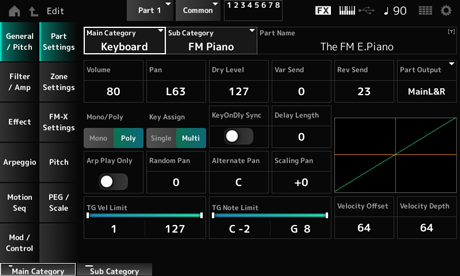
The screen here is basically the same as the one opened from General/Pitch → Part Settings on the Part Edit (AWM2) for the most part; however, the parameters shown below are added.
Sets how the sound is panned randomly left and right for each key played.
The value set in Pan is the center position in the stereo field. Settings: 0–127
Sets how the sound is panned alternately left and right for each key played.
The value set in Pan is the center position for the right and left movement of the Pan. Settings: L64–C–R63
Sets how the position of the key you press affects the position of the Pan setting.
The Pan for the Note Number C3 is the stereo field set in Pan.
By setting this parameter to a positive value, Pan is set to the left for lower keys, and to the right for higher keys.
When this parameter is set to a value of 0, there will be no changes to the Pan setting. When the parameter is set to a negative value, the pan is set to the left for lower keys, and to the right for higher keys. Settings: −64–+0–+63
Sets the timing of the Key On Delay to synchronize with the tempo. Settings: Off, On
Sets the delay time from when the moment the key is pressed to when sound is produced.
This parameter is not available when KeyOnDly Sync is set to On. Settings: 0–127
This parameter is available when KeyOnDly Sync is set to On. You can set the timing for Key On Delay by using musical note values. Settings: 1/16 (sixteenth notes), 1/8 Tri. (eighth-note triplets), 1/16 Dot. (dotted sixteenth notes), 1/8 (eighth notes), 1/4 Tri. (quarter-note triplets), 1/8 Dot. (dotted eighth notes), 1/4 (quarter notes), 1/2 Tri. (half-note triplets), 1/4 Dot. (dotted quarter notes), 1/2 (half notes), Whole Tri. (whole-note triplets), 1/2 Dot. (dotted half notes), 1/4 × 4 (quarter-note quadruplets; four quarter notes to the beat), 1/4 × 5 quarter-note quintuplets; five quarter notes to the beat), 1/4 × 6 (quarter-note sextuplets; six quarter notes to the beat), 1/4 × 7 (quarter-note septuplets; seven quarter notes to the beat), 1/4 × 8 (quarter-note octuplets; eight quarter notes to the beat)
The screen here is the same as the one opened from General/Pitch → Zone Settings on the Part Edit (AWM2).
On the FM-X Settings screen, you can set the FM Color parameters provided as a convenient editing tool for the FM-X sounds as well as the Algorithm (or how the Operators are arranged).
- [PERFORMANCE] → Part Common selection → [EDIT/
] → General/Pitch → FM-X Settings
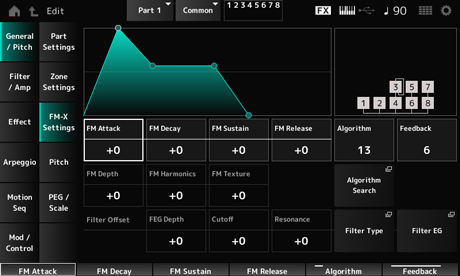
Controls the Attack Time of the EG that changes the depth of the frequency modulation over time. Settings: −99–+99
Controls the Decay Time of the EG that changes the depth of the frequency modulation over time. Settings: −99–+99
Controls the Sustain Level of the EG that changes the depth of the frequency modulation over time. Settings: −99–+99
Controls the Release Time of the EG that changes the depth of the frequency modulation over time. Settings: −99–+99
Changes the Algorithm. Settings: Refer to the Data List.
Feedback causes the Operator to modulate itself by sending some of the output signals back.
Here with this parameter, you can set the degree of such modulation. Settings: 0–7
Changes the depth of the frequency modulation. Settings: −99–+99
Changes the frequency of the harmonic overtones of FM synthesis. Settings: −99–+99
Changes the texture of FM synthesis. Settings: −99–+99
Opens the Algorithm Search screen.
Sets the range of the cutoff frequency change by the FEG. Settings: −64–+63
Changes the sound by setting the cutoff frequency of the filter. When the Low Pass Filter is selected, larger values here result in a brighter sound, and smaller values result in a darker sound.
This parameter is specified as an offset value to the filter cutoff frequency. Settings: −64–+63
Adds special characteristics to the sound by adjusting the signal level near the cutoff frequency.
This is specified as an offset value to the filter resonance. Settings: −64–+63
Opens the Filter/Amp → Filter Type screen.
Opens the Filter EG screen.
The screen here is basically the same as the one opened from General/Pitch → Pitch on the Part Edit (AWM2), except that Legato Slope (Portamento Legato Slope) is invalid.
On the PEG/Scale screen, you can set the pitch envelope generator and scale for the Part.
- [PERFORMANCE] → Part Common selection → [EDIT/
] → General/Pitch → PEG/Scale
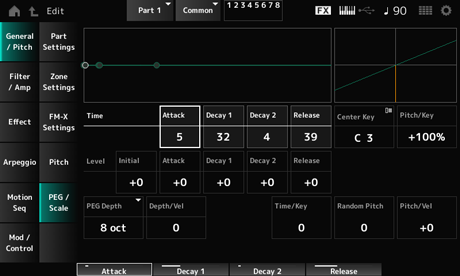
Sets the length of time it takes for the pitch to change from the moment you press a key on the keyboard until the time the pitch reaches the value set at Attack Level. Settings: 0–99
Sets the length of time it takes for the pitch to change from the Attack Level to the Decay 1 Level. Settings: 0–99
Sets the length of time it takes for the pitch to change from the Decay 1 Level to the Decay 2 Level. Settings: 0–99
Sets the length of time it takes for the pitch to change from the moment you have released the key until it reaches the Release Level. Settings: 0–99
Sets the pitch for the moment you press the key. Settings: −50–+50
Sets the pitch to change from Initial Level after you have pressed a key. Settings: −50–+50
Sets the next pitch value to change from the Attack Level. Settings: −50–+50
Sets the next pitch value to change from the Decay 1 Level. Settings: −50–+50
Sets the final pitch to reach after you have released the key. Settings: −50–+50
Sets the amount of pitch change controlled by the PEG. Settings: 8 oct, 2 oct, 1 oct, 0.5 oct
For example, when this parameter is set to 8 oct, you can specify the smallest value to the Pitch EG level to create a pitch change of −4 octaves by sending the pitch value 0 to the internal tone generator, and by specifying the largest value to create a pitch change of +4 octaves.
Sets how the time of the pitch change in PEG responds to Velocity or the strength of the keystroke. Settings: 0–7
Sets how the speed of the pitch change in PEG responds to key position.
The speed change in PEG is used for the specified key in Center Key (fixed to C3). Settings: 0–7
Positive values: The lower the key played, the slower the change in the PEG; the higher the key played, the faster the change in the PEG.
0: No PEG changes regardless of the key position.
Changes the pitch of the Element randomly each time the key is pressed. Settings: 0–127
Sets how the pitch responds to Velocity or the strength of the keystroke. Settings: −64–+63
Positive value: The faster the Velocity, the higher the pitch becomes.
Negative value: The faster the Velocity, the lower the pitch becomes.
0: No pitch change
The screen here is the same as the one opened from Filter → Type on the Part Edit (AWM2) Element Edit.
The screen here is the same as the one opened from Filter → Filter EG on the Part Edit (AWM2) Element Edit.
The screen here is the same as the one opened from Filter → Scale on the Part Edit (AWM2) Element Edit.
The screen here is the same as the one opened from Filter/Amp → Amp EG on the Part Edit (AWM2).
The screen here is basically the same as the one opened from Effect → Routing on the Part Edit (AWM2); however, there are a few differences as shown below.
No output setting for each Element
Cannot select Parallel for Ins Connect
The screen here is the same as the one opened from Effect → InsA or InsB on the Part Edit (AWM2).
The screen here is the same as the one opened from Effect → 3-band EQ on the Part Edit (AWM2).
The screen here is the same as the one opened from Effect → 2-band EQ on the Part Edit (AWM2).
The screen here is the same as the one opened from Arpeggio → Common on the Part Edit (AWM2).
The screen here is the same as the one opened from Arpeggio → Individual on the Part Edit (AWM2).
The screen here is the same as the one opened from Arpeggio → Advanced on the Part Edit (AWM2).
The screen here is the same as the one opened from Motion Seq → Common on the Part Edit (AWM2).
The screen here is the same as the one opened from Motion Seq → Lane on the Part Edit (AWM2).
- [PERFORMANCE] → Part Common selection → [EDIT/
] → Mod/Control → Control Assign
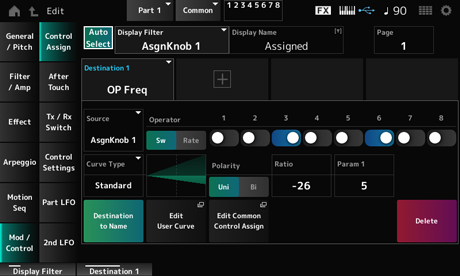
The screen here is basically the same as the one opened from Mod/Control → Control Assign on the Part Edit (AWM2), except that the available Destination settings are different.
For a list of settings, refer to the Data List.
Also, the parameters shown below are the ones available, instead of Element Sw.
You can set the controller setting for each Operator on or off. This parameter is shown only when the selected Destination is related to Operators. Settings: Off, On
Sets the sensitivity of the controller selected for the Destination.
This parameter is shown only when the Destination is set to OP Freq or OP AEG Offset. Settings: −7–+7
Switches between the Operator Sw and Operator Rate.
This parameter is shown only when the Destination is set to OP Freq or OP AEG Offset. Settings: Off, On
The screen here is basically the same as the one opened from Mod/Control → After Touch on the Part Edit (AWM2), except that the available Destination settings are different.
The screen here is the same as the one opened from Mod/Control → Tx/Rx Switch on the Part Edit (AWM2).
The screen here is the same as the one opened from Mod/Control → Control Settings on the Part Edit (AWM2).
On the Part LFO screen, you can set the Part LFO.
- [PERFORMANCE] → Part Common selection → [EDIT/
] → Mod/Control → Part LFO
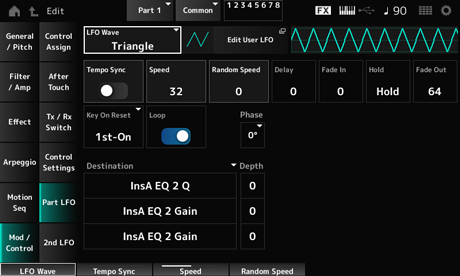
Selects the LFO Wave and sets the type of cyclical changes for the LFOs. Settings: Triangle, Triangle+, Saw Up, Saw Down, Squ1/4, Squ1/3, Square, Squ2/3, Squ3/4, Trapezoid, S/H1, S/H2, User
Opens the User LFO Edit screen.
You can create an LFO waveform of up to 16 steps.
Sets the speed of the LFO Wave changes to synchronize to Arpeggio or Song playback. Settings: Off (not synchronized), On (synchronized)
Sets the speed of LFO Wave changes.
This parameter is not available when Tempo Sync is set to On. Settings: 0–63
Changes the LFO Speed randomly.
This parameter is not available when Tempo Sync is set to On. Settings: 0–127
This parameter is available when Tempo Sync is set to On. You can set the speed of changes in LFO Wave by using musical note values. Settings: 1/16 (sixteenth notes), 1/8 Tri. (eighth-note triplets), 1/16 Dot. (dotted sixteenth notes), 1/8 (eighth notes), 1/4 Tri. (quarter-note triplets), 1/8 Dot. (dotted eighth notes), 1/4 (quarter notes), 1/2 Tri. (half-note triplets), 1/4 Dot. (dotted quarter notes), 1/2 (half notes), Whole Tri. (whole-note triplets), 1/2 Dot. (dotted half notes), 1/4 × 4 (quarter-note quadruplets; four quarter notes to the beat), 1/4 × 5 quarter-note quintuplets; five quarter notes to the beat), 1/4 × 6 (quarter-note sextuplets; six quarter notes to the beat), 1/4 × 7 (quarter-note septuplets; seven quarter notes to the beat), 1/4 × 8 (quarter-note octuplets; eight quarter notes to the beat), 1/4 × 16 (sixteen quarter-notes to the beat), 1/4 × 32 (thirty-two quarter-notes to the beat), 1/4 × 64 (sixty-four quarter-notes to the beat)
Sets the delay time between the moment you press a key on the keyboard and the moment the LFO comes into effect.
The larger the value, the longer the delay time before the LFO comes into effect. Settings: 0–127
Sets the amount of time for the LFO effect to fade in after the delay time set in Delay (LFO Delay Time) has elapsed. Settings: 0–127
The larger the value, the longer it takes for the LFO effect to reach the maximum.
0: LFO changes to the maximum value without any fade-in.
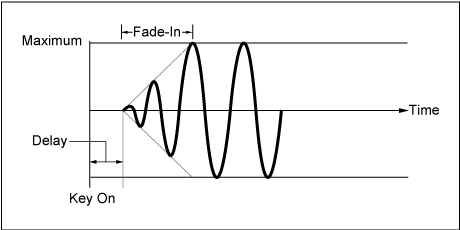
Low value: Fast fade-in
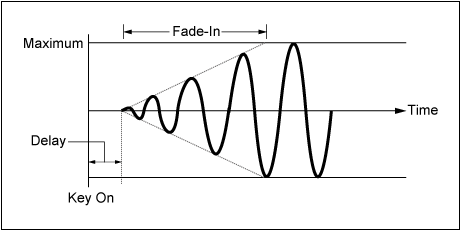
High value: Slow fade-in
Sets the time for maintaining the LFO effect after the maximum level has been reached. Settings: 0–126, Hold
Hold: Does not fade out
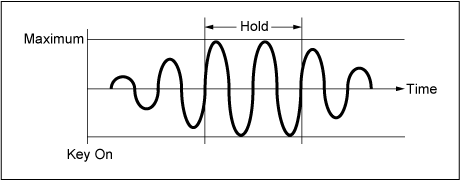
Sets the amount of time for the LFO effect to fade out after the hold time set in Hold (LFO Hold Time) has elapsed.
The larger the value, the longer it takes for the LFO effect to fade out.Settings: 0–127
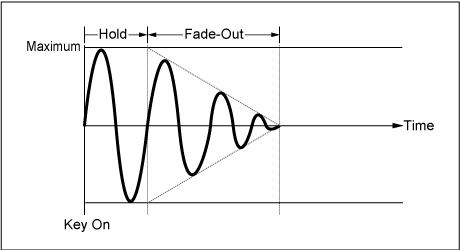
Low value: Fast fade-out
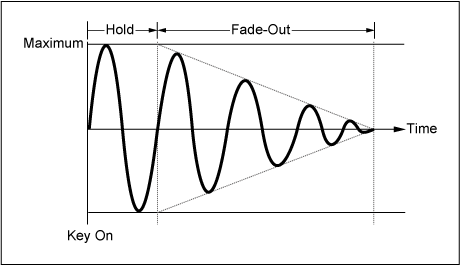
High value: Slow fade-out
Resets the oscillation of the LFO when a key is pressed. Settings: Off, Each-on, 1st-on
Does not reset the oscillation of the LFO. Pressing a key starts the LFO wave at whatever phase the LFO happens to be at that moment.
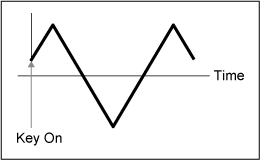
Resets the oscillation of LFO every time a key is pressed and starts the waveform at the phase specified by the Phase parameter.
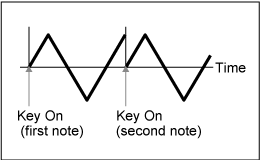
Resets the oscillation of LFO every time a key is pressed and starts the waveform at the phase specified by the Phase parameter.
When the second note is played while the first note is held, playback will not be reset.
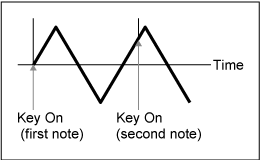
Sets the LFO Wave to loop (repeat) playback or one-shot playback. Settings: Off, On
Sets the initial phase for when LFO Wave is reset. Settings: 0°, 90°, 120°, 180°, 240°, 270°
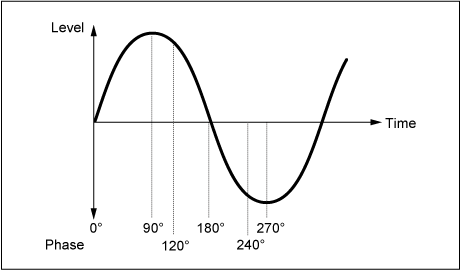
Sets the function to be controlled by the LFO Wave.
Settings: Insertion Effect A Parameter1–24, Insertion Effect B Parameter1–24 (depending on the Insertion Effect)
Sets the depth of LFO Wave control for each Destination. Settings: 0–127
Adjusts the Depth for each Operator.
Set this parameter to Off to turn off the LFO.
This parameter is shown only when the selected Destination is related to Elements.Settings: Off, 0–127
- [PERFORMANCE] → Part Common selection → [EDIT/
] → Mod/Control → 2nd LFO
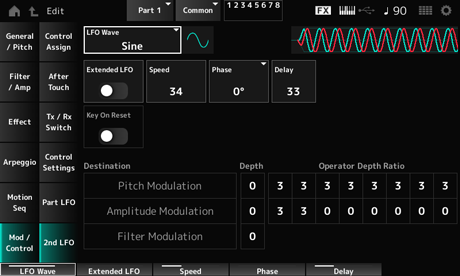
Selects the 2nd LFO Wave.
Settings: Triangle, Saw Down, Saw Up, Square, Sine, S/H
The amplitude modulation phase is shifted with Sine.
Switches between the old set of settings (Off: 0–99) and a new set of settings with higher resolution (On: 0–415) for Speed (2nd LFO Speed).
To maintain compatibility of data created with the old settings, set this parameter to Off. Settings: Off, On
Sets the speed of LFO Wave (2nd LFO Wave) changes. Settings: 0–99 (When Extended is set to Off), 0–415 (When Extended is set to On)
Sets the initial phase for when LFO Wave (2nd LFO Wave) is reset. Settings: 0°, 90°, 180°, 270°
Sets the time length for the 2nd LFO effect to fade in after you have released the key and the delay time set in Delay has elapsed. Settings: 0–99
Resets the oscillation of the 2nd LFO when a key is pressed. Settings: Off, On
This parameter creates a vibrato effect (cyclical changes to the pitch) by using the LFO Wave (2nd LFO Wave), and lets you specify the depth of pitch modulation by the LFO. Settings: 0–99
Sets the depth of the modulation by LFO signals set in Pitch Modulation Depth (2nd LFO Pitch Modulation Depth). Settings: 0–7
This parameter creates cyclical changes in the volume by using the LFO Wave (2nd LFO Wave), and lets you specify the depth of volume modulation by the LFO. Settings: 0–99
Sets the depth of the modulation by LFO signals set in Amplitude Modulation Depth (2nd LFO Amplitude Modulation Depth). Settings: 0–7
This parameter creates cyclical changes to the filter cutoff frequency by using the LFO Wave (2nd LFO Wave), and lets you specify the depth of filter modulation by the LFO. Settings: 0–99